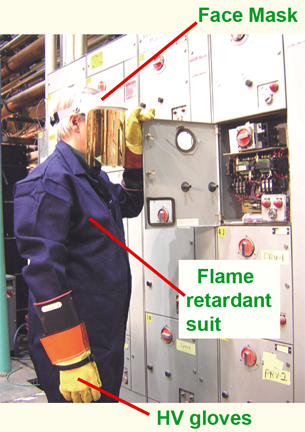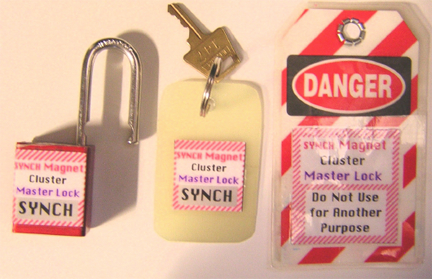You are here: CLASSE Wiki>Safety/Handbook Web>ElectricalSafety (09 May 2023, RigelLochner)Edit Attach
Electrical Safety
Material here is for general electrical information only. Additional training and authorization is required before working on high voltage/power equipment. There is valuable information at the EHS Electrical Safety pages, especially a document detailing electrical hazard evaluation and electrical training guidance: Electrical Safe Work Practices (pdf). In addition, ECMA, an industry standards association, published a useful treatise on Safety of electronic equipment (pdf). A review article on Conduction of Electrical Current to and Through the Human Body is available through the National Institutes of Health website. A plain-English chapter on Electrical Safety appears in the Electronics Technician journal.Electrical Hazards
Electricity is an important tool, but it can be dangerous. Whether you sit at a computer terminal or rewire circuits in the tunnel, you are at risk of becoming the path of an electrical current. Simple safety practices such as checking to see that the work area is dry and uncluttered, an outlet is not overloaded, or that a cord is not frayed may save you from fire, shock, or electrical burns. Under normal conditions, any exposed conducting surface should be considered hazardous if the voltage is higher than 50 V. Note that CLASSE has adopted the Cornell EHS level of 50 V as defining hazardous voltage, but voltage alone is far from the whole story: circuits with low voltages can sometimes deliver hazardous current and/or stored energy. For example, superconducting magnets can operate with low voltage drops but high current and high stored energy, and low voltage buses can sometimes be capable of delivering high current. Due to high capacitance or inductance, even disconnected circuits can have high stored energy. Moreover, abnormal conditions (e.g. the contact area with or path taken through the body, ambient humidity, individual perspiration level, the presence of water on or near the circuit) can increase the hazard level for any given voltage or current. For DC voltages, currents above 25 mA at 50 V are considered hazardous under normal conditions. For common AC outlets (60 Hz, 120 V), current above 10 mA is considered hazardous under normal conditions. The health consequences of contact with common household outlet (120V, 60 hertz) AC current, under normal conditions, versus current (in milliAmperes, or mA) can include:- 1 mA: Usually harmless, but slight tingling or involuntary movement from the shock can cause injury.
- > 5 mA: Painful shock. Possible loss of muscle control.
- >10 mA: Victim may be unable to let go of source.
- >20 mA: Severe shock, nearly certain loss of muscle control, difficulty breathing.
- >75 mA: Possibly fatal.
- 15000 mA: Common fuse breaker opens circuit (i.e. too late to save a person)
Good Housekeeping
Poor housekeeping is the main reason that electricity is the number one cause of fires in the workplace nationwide. Although safety features such as circuit breakers, ground fault circuit interrupters, and insulators are designed to prevent electricity from becoming the heat source for fires, poor housekeeping may still cause a fire. Good housekeeping requires that you:- Clean up liquid spills near electrical equipment immediately and be sure that electrical equipment is thoroughly dry before applying power
- Store flammable liquids away from electrical equipment
- Keep electrical cords away from heat sources
- Do not overload outlets
- Do not plug a power strip into another power strip
- Keep paths to fire extinguishers clear
Two-Person Rule
Never work alone when you could be exposed to hazardous voltages (above 50V) or current (above 25 mA). A second person must stand as a backup. The backup person must be in the immediate area and attentive to the work in progress. He or she must know both where to shut off power and how to call for help. If you are unsure whether you qualify to act in a role of the second person, then consult your supervisor. He or she is responsible for assuring each person's qualifications, and will assign one person to do the work and the other to be the backup.Extension Cords
Damaged and improperly used extension cords cause thousands of electrical fires and injuries in homes and workplaces every year. Before using extension cords, inspect them for cracks, ripped insulation, and damaged or missing grounding prongs. Do not bend back or break off grounding prongs: they are important safety features that receive harmful stray currents. To prevent overheating or possible electrical shock, choose cords rated for current levels that exceed your needs by a safe margin. Never run extension cords through walls, windows, or doorways or behind walls, ceilings, or floors. Never connect extension cords in a series or splice them together. Remove the extension cord when you are finished. Extension cords are not to become permanent fixtures for regular use. If you are setting up or adding new equipment in an area without adequate outlets, the CLASSE Facilities Engineer can arrange to have capacity added.Personal Safety Protection
 Wear proper safety protection when you work with electrical hazards. Gloves may be required (however, do not wear gloves when you are operating a revolving tool, such as a drill or saw). Safety glasses (prescription and non-prescription) and boots or shoes (of many types) are also available with purchase orders from the business office. Wear appropriate personal protective equipment when you are working with power tools, electricity of 50 volts or greater, or heavy equipment. Remember that watches and rings can cause fatal injury by acting as conductors. Remove all jewelry when you are working with power tools or near electrical hazards.
Wear proper safety protection when you work with electrical hazards. Gloves may be required (however, do not wear gloves when you are operating a revolving tool, such as a drill or saw). Safety glasses (prescription and non-prescription) and boots or shoes (of many types) are also available with purchase orders from the business office. Wear appropriate personal protective equipment when you are working with power tools, electricity of 50 volts or greater, or heavy equipment. Remember that watches and rings can cause fatal injury by acting as conductors. Remove all jewelry when you are working with power tools or near electrical hazards.
Know Your Equipment
Before beginning electrical work, check that your diagnostic equipment is in good working order, is properly calibrated, and covers the range necessary for the job. A small, hand-held digital voltage meter (DVM) is commonly used, but you must check the rating on the front of the DVM to ensure that the voltage with which you are working is under the meter's maximum rating. It is dangerous to use a meter on voltages that exceed its maximum rating. Use proper testing equipment and accessories when repairing AC or DC powered equipment. Choose probes and modules carefully because they are rated for different peak voltages. Remember that peak AC voltage is about one and a half times the normally quoted RMS (root mean square) voltage. For instance, the typical 480 volts RMS AC power exceeds the 600 peak voltage rating of some meters. If you are unsure of which probe to choose for the equipment you are planning to work on, then you should use a DVM (with a rating higher than the highest possible voltage in the equipment you are working on) to measure the voltage first. When you are in damp or wet areas, you must power line-operated equipment through a ground fault circuit interrupter (GFCI) . Test each GFCI before using it. Portable GFCIs are available from technical supervisors. Before bench-testing a line-operated chassis, bond metal test benches to the ground and use a circuit breaker to ensure that the current is limited. A ground-fault circuit interupter may provide additional protection. You may also need a second person with you to satisfy the two-person rule. Before testing or working on high voltage equipment or equipment capable of energy storage, note any posted warnings and then de-energize it with a grounding stick. The grounding stick, a metal wand with an insulated handle, is normally built in where needed (near outputs of DC power supplies, filter capacitors, etc.). Always disconnect the energy at its source before using a grounding stick, and, if possible, dissipate any stored energy. Be prepared to encounter stored energy when using a grounding stick. Wear safety glasses to protect your eyes from flying sparks while you securely attach the stick to the equipment. Keep the grounding stick in place so that voltages will not "float up", or come back, while you are working.Lock/Tag/Verify
 The Lock/Tag/Verify system is used to prevent equipment from being powered while someone is working on it. You must obtain the Wilson Lab LTV training session before using this procedure. Use the following steps when locking out machinery for maintenance:
The Lock/Tag/Verify system is used to prevent equipment from being powered while someone is working on it. You must obtain the Wilson Lab LTV training session before using this procedure. Use the following steps when locking out machinery for maintenance: - Announce the shutdown
- Shut off the equipment
- Isolate the equipment from its energy source
- Apply a lock to the disconnect or circuit breaker, and use a tag that states your name, the date, and the reason for the lockout
- Dissipate any stored energy
- Verify that the equipment will not operate, returning the controls to the off position
- Remove all tools and other loose objects from the area; reinstall any guards
- Notify all affected workers
- Verify all controls are off
- Remove the lock and tag and restore power
Electrical Emergencies
For emergency contacts, see Emergency Numbers. Common sense and the following basic guidelines will help you avoid serious harm in electrical emergencies involving fire, shock, or burns.- Fire: See Fire Safety. If you see a fire, pull the nearest fire alarm. Switch off the power to the area if you can do so safely. In the CESR tunnel, it is often best to push a crash button or pull the crash cord to turn off power. If the fire is small and contained, and If you have been trained in fire extinguisher use, you may attempt to extinguish it; otherwise leave the area immediately and then notify the CESR Operator of the fire. If you attempt to put out a small, contained fire, use an extinguisher that is designated A-B-C, or B-C. (Never use just a Class A, or water extinguisher, on an electrical fire.) Always be on guard for the presence of hazardous voltages when extinguishing a fire. If the fire does not extinguish easily, leave the area and notify the CESR operator.
- Electrical Shock: If you find an unconscious person who is in contact with a power source, DO NOT, under any circumstances, touch the person or the wire itself. Disconnect the source of power first. Again, the best way to turn off equipment in the tunnel is to push a crash button or pull the crash cord. If you cannot turn off the source of power, then disconnect the victim from the source of power with a long, non-conductive object such as a broom or a rope. Designate a specific individual to call 911 and give the details of the accident. Once the unconscious person is disconnected from the source of power, use the ABCs of first aid to determine if the person is breathing. Stay with the victim, cover any wounds with sterile dressing, and wait for help to arrive.
- Burns: Treat electrical burns with care. If you or a co-worker has been burned, call 911 immediately for help. Refer to chapter ten for more emergency information.
End of Electrical Safety
Edit | Attach | Print version | History: r31 < r30 < r29 < r28 | Backlinks | View wiki text | Edit wiki text | More topic actions
Topic revision: r31 - 09 May 2023, RigelLochner
-
 Safety/Handbook Web
Safety/Handbook Web
-
 Create New Topic
Create New Topic
-
 Index
Index
-
 Search
Search
-
 Changes
Changes
-
 Notifications
Notifications
-
 RSS Feed
RSS Feed
-
 Statistics
Statistics
-
 Preferences
Preferences
- Webs
-
 ACC
ACC
-
 ACL
ACL
-
 Bunch
Bunch
-
 Private
Private
-
 BusinessOffice
BusinessOffice
-
 CBB
CBB
-
 NSF
NSF
-
 CBETA
CBETA
-
 CESR
CESR
-
 Private
Private
-
 CHESS
CHESS
-
 FMB
FMB
-
 Maia
Maia
-
 XIMG
XIMG
-
 CHEXS
CHEXS
-
 CLASSE
CLASSE
-
 Communications
Communications
-
 CLEO
CLEO
-
 AC
AC
-
 Administration
Administration
-
 RunMan
RunMan
-
 SW
SW
-
 CMSPhase2MREFC
CMSPhase2MREFC
-
 Computing
Computing
-
 Blogs
Blogs
-
 Newsletter
Newsletter
-
 Obsolete
Obsolete
-
 Private
Private
-
 Cosmology
Cosmology
-
 Private
Private
-
 DarkPhoton
DarkPhoton
-
 ERL
ERL
-
 Private
Private
-
 EngineeringDesignDrafting
EngineeringDesignDrafting
-
 G2
G2
-
 HEP
HEP
-
 DBSWorkshop
DBSWorkshop
-
 SWIG
SWIG
-
 HLLHCCMSMREFC
HLLHCCMSMREFC
-
 HMF
HMF
-
 HumanResources
HumanResources
-
 Private
Private
-
 ILC
ILC
-
 Americas
Americas
-
 CesrTA
CesrTA
-
 Proposal
Proposal
-
 DampingRings
DampingRings
-
 AreaLeaders
AreaLeaders
-
 CTA09
CTA09
-
 ILCDR06
ILCDR06
-
 ILCDR07_KEK
ILCDR07_KEK
-
 ILCDR08
ILCDR08
-
 S3TaskForce
S3TaskForce
-
 Private
Private
-
 CesrTA
CesrTA
-
 WWS
WWS
-
 MacCHESS
MacCHESS
-
 Main
Main
-
 People
People
-
 PhotocathodeBrightBeams
PhotocathodeBrightBeams
-
 REU
REU
-
 Private
Private
-
 SRF
SRF
-
 PCsrfcn1
PCsrfcn1
-
 Safety
Safety
-
 Handbook
Handbook
-
 Private
Private
-
 ExternalResources
ExternalResources
-
 Sandbox
Sandbox
-
 TestWeb
TestWeb
-
 Testauth
Testauth
-
 System
System
-
 Theory
Theory
-
 Communications
Communications
-
 Documents
Documents
-
 Phase2MREFC
Phase2MREFC
-
 WebDev
WebDev
-
 Private
Private
 Copyright © by the contributing authors. All material on this collaboration platform is the property of the contributing authors.
Copyright © by the contributing authors. All material on this collaboration platform is the property of the contributing authors. Ideas, requests, problems regarding CLASSE Wiki? Send feedback



